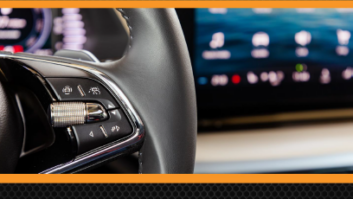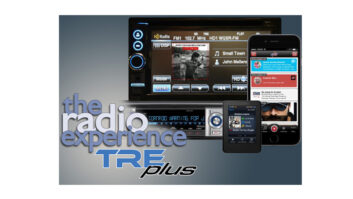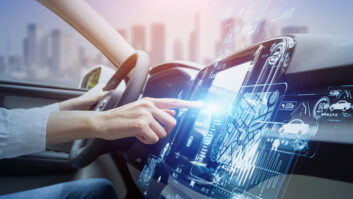One in a series of articles intended to familiarize readers with the range of automotive infotainment platforms now on the market.

Hyundai’s compact, connected 2017 Elantra sedan.
Credit: Paul Kaminski

An AM station on the screen.
Credit: Paul Kaminski Not only do Hyundai’s “connected cars” have a 100,000-mile limited powertrain warranty; more and more of them are using Apple CarPlay and Google’s Android Auto to make driving convenient, entertaining and safer. When combined with the BlueLink vehicle telematics system, built-in apps like Pandora and the vehicle’s audio systems (base and optional), there’s a forest of choices for what can be seen on the display in the center stack of Hyundai dashboards. Those three systems make up Hyundai’s version of what we call a “connected car.”
As part of my recent test of a Hyundai Genesis and 2017 Hyundai Elantra for the “Radio-Road-Test” program, I put the audio, BlueLink and Android Auto systems through their paces.
Hyundai’s BlueLink system keeps tabs on vehicle status and systems (such as remote starting, locking/unlocking, vehicle system diagnostics and maintenance reminders, etc.) and shares center stack touchscreen time with the audio apps and on-board audio systems. When using the CarPlay and Android Auto connection to the compatible smartphone, drivers will see small icons on the center stack screen to make quick choices between navigation (maps), music apps and the phone, for example. To make more detailed choices safely, the system “greys out” those choices from other on-screen menus until the vehicle is stopped.
Miles Johnson, senior public relations manager for Hyundai quality, service and technology, explained that the BlueLink system “works off an embedded modem with a 4G connection. CarPlay and Android Auto work off smartphones.” To connect either an iPhone or Android device, the user connects with the appropriate USB connection cord.
The Android Auto capability debuted on the 2015 Hyundai Sonata. CarPlay and Android Auto capabilities are now available on the 2016 Sonata and the 2017 Elantra. Both CarPlay and Android Auto will find their way to more models in the Hyundai line.
AUDIO
On the Elantra and the Sonata, for example, one can find a pushbutton to get the touchscreen in the center stack to the radio screens, where settings can be configured for AM/FM and HD Radio reception.


This is a Hyundai audio display or center stack. Will content from your radio station convince listeners to take the steps to make your station show up here?
Credit: Paul KaminskiThe home screen on a Hyundai Elantra. To get to the radio screen, press the physical radio button located below the screen.
Courtesy Hyundai
HD Radio capability is standard on the 7-inch touchscreen display audio system and also on the 8-inch touchscreen navigation upgrade. The base model has AM/FM and SiriusXM reception capability.
Another option is to “bring-your-own” audio via connection with a patch cord or USB. The USB connection is also how Hyundais connect using CarPlay and Android Auto, with the native music apps contained on the connected smartphone. The vehicle’s audio system can be controlled by a mix of new-school techniques (touchscreen and voice recognition) and also by old-school buttons and knobs.

How SiriusXM shows up.
Credit: Paul Kaminski

Hyundai’s virtual reality owner’s manual helps owners program their audio systems.
Courtesy Hyundai As an option for upgrades from the base AM/FM and SiriusXM audio system, Hyundai offers Sirius XM NavTraffic, NavWeather, as well as sports and stocks in a three-month trial. That data is delivered separately from the data received and transmitted via the smart phone for apps like Pandora, for example. BlueLink data is delivered by a dedicated and embedded 4G modem; BlueLink data works with vehicle control, some navigation information (directions) and alerting information.
Part of Hyundai’s delivery process, whether it’s a custom-ordered vehicle or a model in stock, includes working with the new owners (post-delivery if necessary) so they can easily tune in to their favorite radio stations and navigate through the audio system to use certain apps.
“Hyundai’s customers love to have the freedom of choice,” Johnson says. “That’s why we provide them with CarPlay, Android Auto, Blue Link, Sirius XM and HD Radio.”
What does this mean for a radio station with a heavy advertising schedule from a Hyundai dealer or for a radio station that would like to have such a schedule? That station should be working closely with dealer reps, who help new customers get the most out of their new Hyundai’s infotainment system.
Before a radio station begins this outreach, the station should ensure that song metadata is entered accurately, all of the RDS data systems are working properly and that station sound is optimized. It should go without saying that compelling content — whether broadcast on an HD channel, primary FM or AM channel, or streamed via an app — is what will convince listeners to take the time to navigate through the forest of choices.
As we prepare future articles about connected car ecosystems, what other questions should we be asking? Email me via Radio World at [email protected].
Paul Kaminski, CBT, is producer and host of msrpk.com’s “Radio-Road-Test” program. Reach him on Twitter (@msrpk_com) and on Facebook (PKaminski2468).












